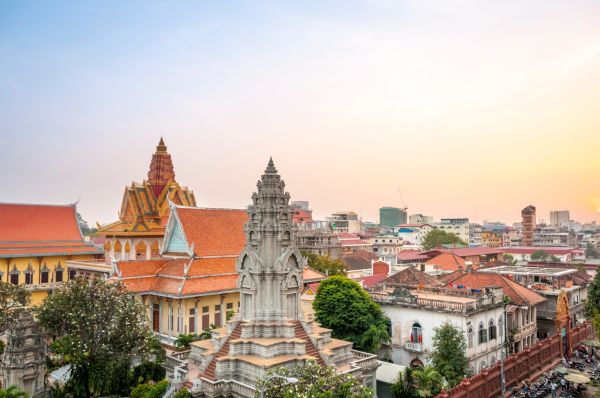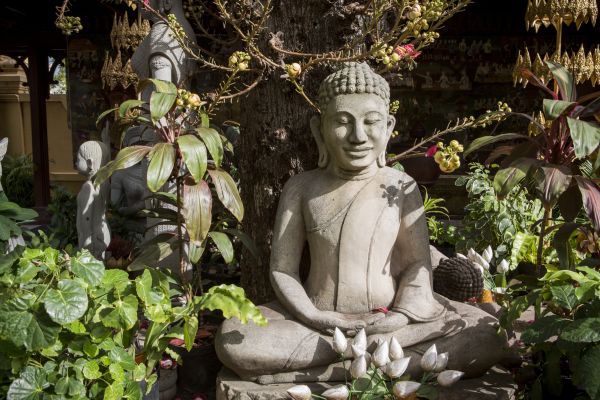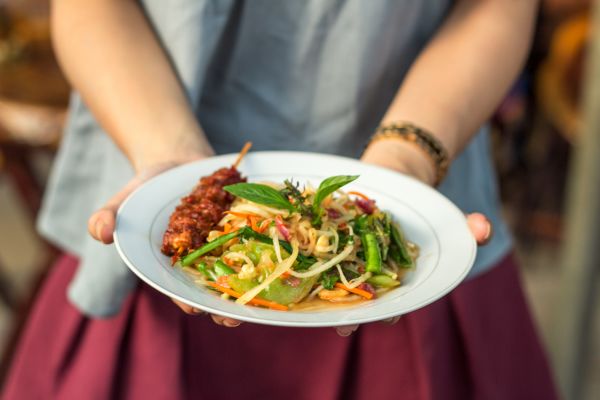Phnom PenhTravel Guide
Cambodia is known as the Kingdom of Wonder and its capital city, Phnom Penh, is wonderous in its own right. Situated at the junction of three rivers — the Bassac, Tonlé Sap and Mekong — Phnom Penh offers visitors an exhilarating blend of history, culture and contemporary local life.
The biggest city in Cambodia, Phnom Penh, is home to more than two million people and it’s constantly growing and changing. Established in 1434, it’s famed for architectural gems — Buddhist temples and monasteries, the Royal Palace and the Silver Pagoda, and French colonial villas and boulevards.
And there’s still more to see if you’re willing to peel back the curtain. Exciting markets bring you closer to the life of the locals; the city’s growing culinary scene deliciously fuses street food with international cuisine, while lively riverfront bars provide the perfect setting for watching the sunset over the water.
Explore Phnom Penh
Where to stay in Phnom Penh?
While most visitors stay near Riverside (Sisowath Quay) as it’s close to Phnom Penh’s main attractions, plenty of boutique hotels and guest houses are scattered throughout the city.
If you’re seeking a luxury hotel in Phnom Penh, look no further than Raffles Hotel Le Royal, just a stone’s throw from the famous Wat Phnom Buddhist temple. Raffles Le Royal opened her doors way back in 1929 and she’s all about combining old-world charm with modern sophistication. She boasts two swimming pools and fine dining on-site with French and local Khmer cuisine on the menu.
With dorms and private rooms, the Onederz Hostel is ideal if you’re on a tight budget. Get to meet fellow travellers at the rooftop pool and bar area while feasting your eyes on the view over the Tonlé Sap River. The hostel offers Western, Khmer and Japanese cuisine and is near a bus station.
Sisowath Quay is where all the action is and if that’s where you’d like to stay, then Point Boutique Hotel is a good option for mid-range accommodation. The rooms have all the modern conveniences needed for a comfortable stay — fast WiFi, air-con and room service. The gin bar on the top floor is a bonus, offering incredible views over the Mekong River.
Looking for an upmarket hotel in Phnom Penh that’s within walking distance of some of the city’s main attractions? Then Palace Gate Hotel & Resort should be top of your list. Set in a restored French colonial villa right in front of the Royal Palace, a stay here makes sightseeing super easy.
Believe us when we say, this is just the start. Book your Phnom Penh accommodation today!
Things to do in Phnom Penh
The Khmer people are native to Cambodia and make up most of the population. As such, their history and culture are reflected in every corner and in Phnom Penh too, with many places of interest that’ll stir the soul. From visiting towering temples, palaces, art galleries and museums to partying with the locals, there’s no shortage of things to do in Phnom Penh.
The Wat Phnom pagoda is an important local landmark, set on the only hill in Phnom Penh in Norodom Boulevard. There’s a fascinating legend about how the hill was man-made and led to the construction of the pagoda in 1373. It houses a collection of Buddhas and is linked to the origins of the city and its identity.
With a prime location on the riverfront, the golden Royal Palace is a stunning example of Khmer architecture and was built for the King of Cambodia and his family. The palace complex is home to several must-see buildings, such as the Throne Hall and the Silver Pagoda, so called for its silver floor made of more than 500 solid silver blocks. The pagoda is used for important ceremonies of the royal family.
We also recommend a visit to the National Museum, situated next to the Royal Palace, which features a fascinating collection of Khmer art.
Around 17 kilometres outside the city, in Roluos Village, the Killing Fields of Choeung Ek war museum (also called the Choeung Ek Genocide Centre) is an educational site that details Cambodia’s tragic past. This is where around 17,000 people were brutally killed by the Khmer Rouge regime. The site is open daily for visitors to learn more and pay their respects. Please note that the displays are not for the sensitive or for children.
If you’re visiting Cambodia between October and November, you can participate in Bon Om Touk, also known as the Cambodian Water Festival. This three-day event, celebrated for centuries, marks the end of the monsoon season. A series of activities take place across the country, such as fireworks and dragon boat races (long canoes decorated with dragons originating in China). The best place to experience the festival in Phnom Penh is on Sisowath Quay.
Take a stroll down the Sisowath Quay promenade along the Mekong River. This scenic walk takes you past the many vibey restaurants, bars and cafés where you’ll find the perfect pit stop. This strip is also known for stunning rooftop bars, so while you’re enjoying a drink or a bite to eat, you might like to decide where to return for the evening!
Looking for an immersive experience? Then a Phnom Penh tour is the way to go.
Phnom Penh food and drink
Cambodia’s capital is a home to wild and wonderful flavour sensations waiting to be tasted. At its heart is Khmer cuisine, over a thousand years old and split into rural, elite and royal cuisines. Essentially the “higher” you go, the more meat and quality ingredients are incorporated. As time went on, Khmer cuisine was influenced by the Chinese, Indian and French, making for a fascinating blend on the plate. From streetside vendors and pavement noodle shops to five-star restaurants, Phnom Penh cuisine is guaranteed to satisfy — and surprise — your taste buds! (Fried tarantula, anyone?)
If you’re keen to try authentic Khmer cuisine, the restaurants at most boutique hotels serve some local dishes. But while you’re in the city, we recommend Malis Phnom Penh, headed up by Cambodia’s one and only Master Chef. This upmarket restaurant offers dining in a stunning courtyard setting and is all about preserving Cambodian food heritage, best showcased by its signature dishes.
Another option is Kravanh, said to have pioneered Khmer fine dining in Cambodia. The restaurant can be found in a gorgeous colonial villa surrounded by lush gardens and with the option to dine indoors or out. The menu features classic Cambodian dishes made with sustainable, organic ingredients.
For authentic Indian food with a modern twist, snap up a table at the upmarket Namaste India Restaurant near the Independence Monument. Featuring Mughlai and North and South Indian dishes, with an imported tandoori clay oven for dishes like butter chicken, Namaste India is also known for its friendly service.
Sophisticated French flair and an eclectic menu is what you’ll find at Le Langka. This fascinating little restaurant also dishes up Italian-, Japanese- or Thai-inspired dishes alongside typical French favourites like duck breast. There’s a wonderful cocktail menu too!
Far on the other end of the scale is the no-frills, stark, but highly praised Khmer Women’ Food. When travelling in Asia, it’s often not about the setting when it comes to hole-in-the-wall culinary gems. It’s about down-to-earth, delicious, authentic cuisine. At Khmer Women’ Food it’s made with love, from scratch, by the matriarch chef, and you can watch her in action in the open-plan kitchen.
Street food stalls can be found everywhere in Phnom Penh but the markets — Central Market, the Russian Market and the Night Market — are also good places to kick off your street food journey. Look for the bustling food court where you can perch on a plastic stool and taste your way through yakitori chicken skewers, num banh chok (Cambodian noodles) or kralan (sticky bamboo rice).
Get a real taste for the local cuisine by booking a Phnom Penh tour.
Where to shop in Phnom Penh?
Malls and markets are dotted across Phnom Penh, and once you see the prices, you’re guaranteed to head home with a bag full of treasures!
Want to escape the crowds? Head to Street 240 with its trendy cafés, restaurants, art galleries and pop-up boutiques. Situated in the heart of Doun Penh, you’ll find it between the Independence Monument and Wat Botum Park, along the wall of the Royal Palace.
Aeon Mall is one of Phnom Penh’s top shopping malls. Along with a diverse selection of branded stores, it also has an impressive food court on the top floor, a cinema, a karaoke lounge, arcades and an ice rink!
You’ll find that many tuk-tuk drivers will call out to you to offer a ride to the Russian Market. And it’s a fabulous place to shop! You’ll find everything from silk scarves and spices to woodcarvings, antiques and souvenirs. As for its name? It was once a popular spot for Russian expats in the 1980s — you can still find a few Russian dolls and flags for sale. The Russian Market is open daily from 6am – 4:30pm.
Many visitors get their shopping introduction to Phnom Penh at the sprawling Central Market. You can pretty much pick up anything here, even on a shoestring budget, from clothing and jewellery to street food and souvenirs. And like most markets in Phnom Penh, you can also negotiate what you’re able to pay. Set inside a yellow art deco building on Street 130, it’s also easy to find.
When is the best time to travel to Phnom Penh?
Phnom Penh has a tropical monsoon climate, which creates two seasons: dry and wet! The dry season is from late November until the end of April. The wet (rainy season) is from May to November.
The dry season is the coolest time of year, although technically not that cool. Temperatures are around 26°C (79°F). While this time of year promises exceptional weather to explore Phnom Penh, note that peak season is from October to March when attractions are the most crowded and you’ll pay higher rates for accommodation.
In terms of temperatures, the best time to visit Cambodia would be from December to February when it’s between 21°C and 32°C (70°F – 90°F).
March and April are the hottest months and can get pretty uncomfortable with the temperature hitting as high as 40°C (104°F)! May and June are also hot, and the humidity is high, so it feels even hotter!
During the rainy season (May to November), the showers are intense, but they’re over quickly. They generally also happen in the afternoons so you can plan around them. This is low tourist season, so you’ll be able to snap up some great flight and accommodation deals.
Don't miss out. Book your Phnom Penh flight today!
How to get around Phnom Penh
Phnom Penh isn’t the most walkable city. The pavements are often obstructed, and the traffic can get quite heavy. While you can wander around the central area and the Sisowath Quay promenade on foot, going further out, you’ll need an alternative.
Without an official public transport system, the next best option is to get around using tuk-tuks (with a negotiated fare) or metered taxis. Download the PassApp, the local equivalent of Uber, and easily order a tuk-tuk or taxi.
Phnom Penh’s train station is on St 93, next to the University of Health Sciences and the Canadian Embassy, so it’s possible to explore more of Cambodia by train. Download a booking app like Bookaway, and you’re set! You’ll also be able to buy tickets for the buses and minivans on the app.
Water taxis on the Mekong and Tonlé Sap rivers offer a scenic travelling option from Phnom Penh to destinations such as Siem Reap, Battambang, various coastal towns and the Southern Islands. The water taxi to Siem Reap, for example, departs the Sisowath Quay pier daily at 7am. You can also choose to travel on the rivers by ferry.
Feel like living large? Charter a helicopter transfer or private speed boat!
Let us help you organise your own wheels for exploring. Hire a car in Phnom Penh today!






